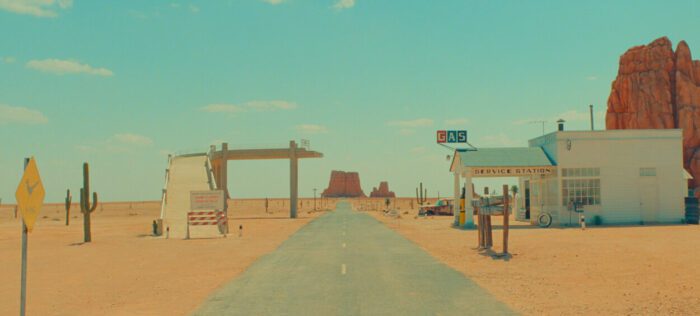The platitudinous way to summate each successive Wes Anderson film is to deem it the “most Wes Anderson film Wes Anderson has ever made.” With Asteroid City, this pithy slogan quickly pervaded the discourse, for obvious reasons. Anderson’s stylistic and visual signifiers are all there: the pastel patina, the conflation of foreground/background, the mannered (dis)affection of emotionally damaged/stunted souls, the precociously smart wunderkinds, the sad-sack protagonist with a film camera slung around his neck, the mannequin-style tableaux. Anderson’s knack for hand-crafting milieus of totalizing and seamless artifice is uncanny and remarkable, patenting an entire tone and aesthetic under his namesake.
I’m hesitant, however, to reduce Anderson’s latest to the aforementioned bromide. While Asteroid City hones many of the long-standing leitmotifs and meticulous doll-house mise-en-scenes we’ve come to associate with Anderson’s signature world-building sensibility, the dense and labyrinthine narrative layering within it is quite unlike anything he’s previously accomplished (besides maybe The Grand Budapest Hotel (2014) and The French Dispatch (2021), which showed the first inchoate signs of Anderson’s notable and novel leap in postmodern complexity).
If one can hypothetically categorize Bottle Rocket (1996) and Rushmore (1998) as the first quasi-realistic iteration of his Anderson’s career, and The Royal Tenenbaums (2001) to Moonrise Kingdom (2014) as the fanciful second, then Asteroid City (2023) is clearly the apotheosis of his latest maturation cycle, crystallizing with an entirely new syntax: the gradual transition from small analogical ruptures of the fourth-wall (as in The Life Aquatic, allowing the audience to omnisciently oversee the construction of the Belafonte set) to full-blown meta-deconstruction.
Tracking backward, it becomes clear how incremental Anderson’s intricate, nested Russian-doll storytelling techniques have evolved ever so gradually over his oeuvre, culminating (at least for now) with Asteroid City, which possesses Pynchonian multidimensionality and Kaufmanesque self-reflexivity. As Adam Nayman chronicled in his review on The Ringer, “Welcome Back to Wes World,” Anderson has steadily introduced “metafictional escape hatches” and navel-gazing substructures into his fables piece-by-piece:
“Think of The Grand Budapest Hotel and its flashbacks within flashbacks, or The French Dispatch, which was structured as a series of feature reports and essays within an issue of a New Yorker–style periodical.”
Although Anderson has been teasing Synecdoche, New York-levels of recursive enfolding, this inward spiraling is no longer just a stylized bauble. It is, in fact, the primary motif in Asteroid City. Sure, there are the familiar ornamental dioramas and deadpan levity, but the ersatz qualities of his painstaking simulations are now doubly caricaturized: the fabrications made explicit within the text itself.
Anderson has graduated from the realm of curation and pastiche, and entered an entirely new phase altogether, enveloping his stories within the mythology of their unfolding. The historical references (Boomer-era family vacations, the space craze, atom bomb experiments), alien invasion stories (flying saucers, governmental gaslighting, quarantining), western tropes (the diner, cops and bandits car chase, staged Monument Valley replica), and cartoonish visual gags (the roadrunner, the offramp to nowhere, the triplets cleaning out the backseat of the car) remain; but behind all these signifiers is a brooding meditation on the labor, pain, sadness, and interpersonal dynamics that inspire synthetic imitations.

As seen in The French Dispatch, Anderson is now keen on chronicling both the story and the storyteller; here, he’s interweaving a play within a play within a throwback TV program hosted by Bryan Cranston (Or it may be the other way around, given the circularity of everything). The black-and-white interludes, detailing the construction of the stage-play that became the TV program we’re inhabiting for most of the movie, serve as brilliantly rendered framing devices. For one, Anderson situates the audience at a remote, fixed distance to mimic the restraints of theater-confined storytelling, which remains static and staged two-dimensionally whereas cinema/TV enjoys kinetic circularity (the latter of which is embellished in our first introduction to Asteroid City, wherein Anderson pans, then spins the camera 360 degrees).
This alone is quite savvy, but Anderson’s keen on not only showing the way the narration is adapted and altered from medium to medium; he’s also preoccupied with revealing the way everyday life inflects itself upon both stage and screen and vice-versa, creating a sort of chiasmic intertwining or entanglement of reality informing art and art informing reality. That’s why we witness the genesis of casting decisions (Woodrow Steenbeck [Jake Ryan] being plucked from his role as a letter courier), peripheral love affairs (between Schubert/Adrien Brody/director and Midge/Scarlett Johansson/actress) manifesting into storylines, actorly insecurities becoming defining character traits and dispositions (Jonas Hall’s [Schwartzman in actor mode] fine-tuning of Augie Steenbeck [Schwartzman in character mode] via intimate conversations with the playwright Conrad Earp, played by Edward Norton), and an entire method-acting ensemble (led by Willem Defoe as Saltzburg Keitel, a fictional surrogate of Sanford Meisner) falling under the spell of an hypnotic induction during a rehearsal, signifying the performative trance-state of becoming (an)Other.

In her stellar Film Obsessive review, Tina Kakadelis astutely calls out the film’s mechanical fastidiousness as an impediment, stifling its heartbeat: “With every aspect of the film feeling planned in such a minuscule way, it’s impossible to deliver the gut punch the theme requires.” This is an accurate diagnosis and one that has been echoed often by those seeking a resonant emotional walloping within Wes Anderson’s quirky compilations. At the same time, the lack of emotion can also be viewed as indicative of a larger commentary on the dehumanization of the emotional self in postmodernity. As Paul Schrader pointed out, “[Wes] has distilled his design-driven anti-empathy film style to its essence.” With this reading, it is possible to see Wes Anderson’s phlegmatic compositions as intentionally impassive.
Surrounded by facsimiles, suffocated by simulacra, and smothered by the weight of existence, Anderson’s characters resemble the unfeeling intellectual objectivity of a hyper-regimented world. And while this emotional vacuity can feel limiting, rehearsed, and over-engineered for many, it also feels essential to Wes Anderson’s primary critique of art as something that both expands and yet flattens reality. The stolid temperaments are by design, replicating the superficial contours of dramaturgical fantasies.
By the end of Asteroid City, the dualistic nature of sleep and waking reality (“You can’t wake up if you don’t go to sleep.”), the actual self and the acting self (“You’re the wife who plays my actress.”) grow indecipherable as art transcends its own event horizon. At a certain threshold, creation becomes reality itself, imprinting itself on life by collapsing and distorting all distinctions to the point of disassociated ambiguity. With this overarching teleology, Wes Anderson’s understanding of his work has become as quantum-dimensional as the layers of his storytelling; he’s now tapping into a very surreal and cosmic concept of art as a human instrument with the capacity to redefine the spatiotemporal conditions of existence, forging an alien and amalgamated liminality. Through the steady self-effacement of repetitive inculcation, the chrysalis of persistent distillation, and the ouroboric endpoint of creative sublimation, art can forge a metaphorical spaceship, ferrying the soul between dreamscapes of physical and metaphysical polarities.


